Featured Comment:
“My family really liked this and it was fun to make. We’ve been watching the Spy Family Anime and wanted to try hambagu. For Americans, I would say that this dish is not like Salisbury Steak, it’s more like a meatball or anindividual meatloaf, with a more refined sauce on top. Try it!”
– Stacye (from Pinterest)
What is Hambagu (Japanese Hamburger Steak)?
Hambāgu (ハンバーグ) is Japan’s inventive take on the hamburger, blending traditional and global flavors. Essentially, it’s a patty made from a mix of beef, pork, onions, panko breadcrumbs, eggs, and seasonings, pan-fried to perfection.
The dish’s roots trace back to the 13th-century “Steak Tartare” introduced by Mongols to Europe. As it traveled, it adopted various ingredients, eventually becoming the “Hamburg Steak” in Germany, which the US adopted.
Japan introduced this dish in 1882 as the “German steak” or “minced ball,” simply beef fried with tomato sauce.
Its popularity in Japan began in the 1960s, reflecting the nation’s evolving tastes. While it might remind many of a bun-less hamburger, it fits seamlessly into Japan’s rice-centric cuisine.
In the US, there’s a dish that resembles hambagu called “Salisbury Steak”. It’s made with beef patties served in a thick gravy sauce, but they are not directly related despite their similarities.
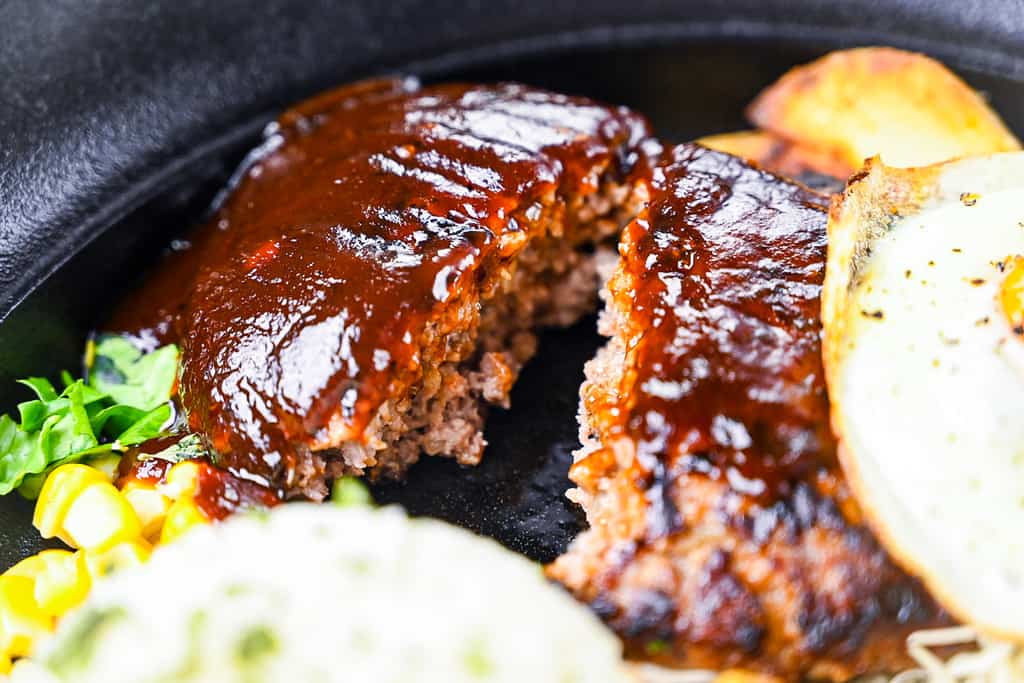
Meat Options for Hambagu
As I mentioned, historically in Japan, people often mix pricier ground beef with cheaper ground pork to enjoy tasty hambagu without breaking the bank.
Pork and beef mixture is often preferred even today, not only because of its cost-effectiveness but because it produces more flavor than beef alone. Additionally, the fat from the pork makes it delicious even when cooled, making the texture juicy and tender.
1. Ground Beef and Pork Mix (Recommended)
As for the ratio, if you want a solid beefy/meaty flavor, go for 7:3 or 8:2 beef-to-pork ratio. If you want a richer flavor and smooth texture, you can use a higher percentage of 6:4 beef-to-pork.
Also, if you grind these meats yourself, I recommend grinding beef coarsely but pork finely. This allows a small amount of pork evenly distributed throughout the beef.
2. 100% Ground beef
On the other hand, 100% beef hambagu can be dry and tricky to shape due to the mix of lean and fatty meat. Some specialty restaurants sell 100% beef hambagu, but if you want to make them yourself, you’ll need to get creative with your choice of beef cuts, lean/fat ratio in mind.
The great thing about all-beef hambagu is that they don’t need to be fully cooked so you can enjoy them rare or medium-rare.
3. 100% Ground pork
For a tender option, 100% pork hambagu is popular with kids. Although they’re higher in fat, they have a rich, soft texture. However, hambagu with 100% pork mince can lack some meatiness.
4. Ground chicken (not recommended for this recipe)
While chicken hambagu certainly exist, they’re not nearly as popular as beef or pork hambagu. For this recipe in particular, I don’t recommend using chicken mince since you need different seasonings and quantities to compliment the flavor of the chicken.
Chicken hambagu also works better with a thicker, creamier sauce (rather than the rich demi-glace-inspired sauce that I included in this recipe).
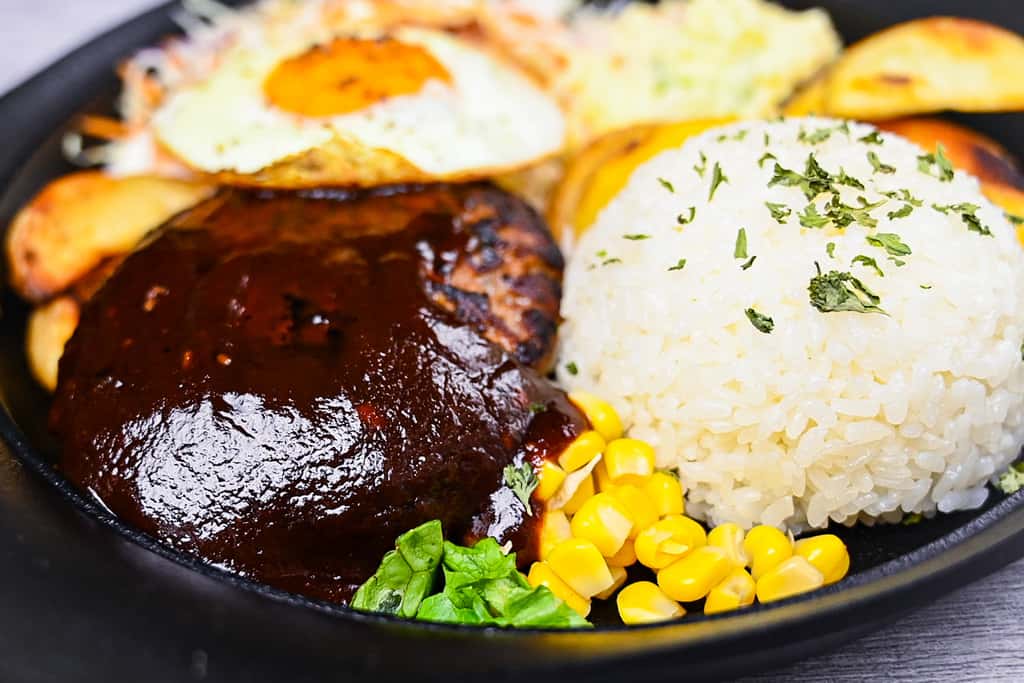
Visual Walkthrough & Tips
Here are my step-by-step instructions for how to make Japanese Hambagu at home. For ingredient quantities and simplified instructions, scroll down for the Printable Recipe Card below.
For added sweetness, I like to fry the onions before adding them to the patty mixture. Heat a pan on medium, melt some butter, and fry the finely diced onion until it becomes soft and slightly translucent.
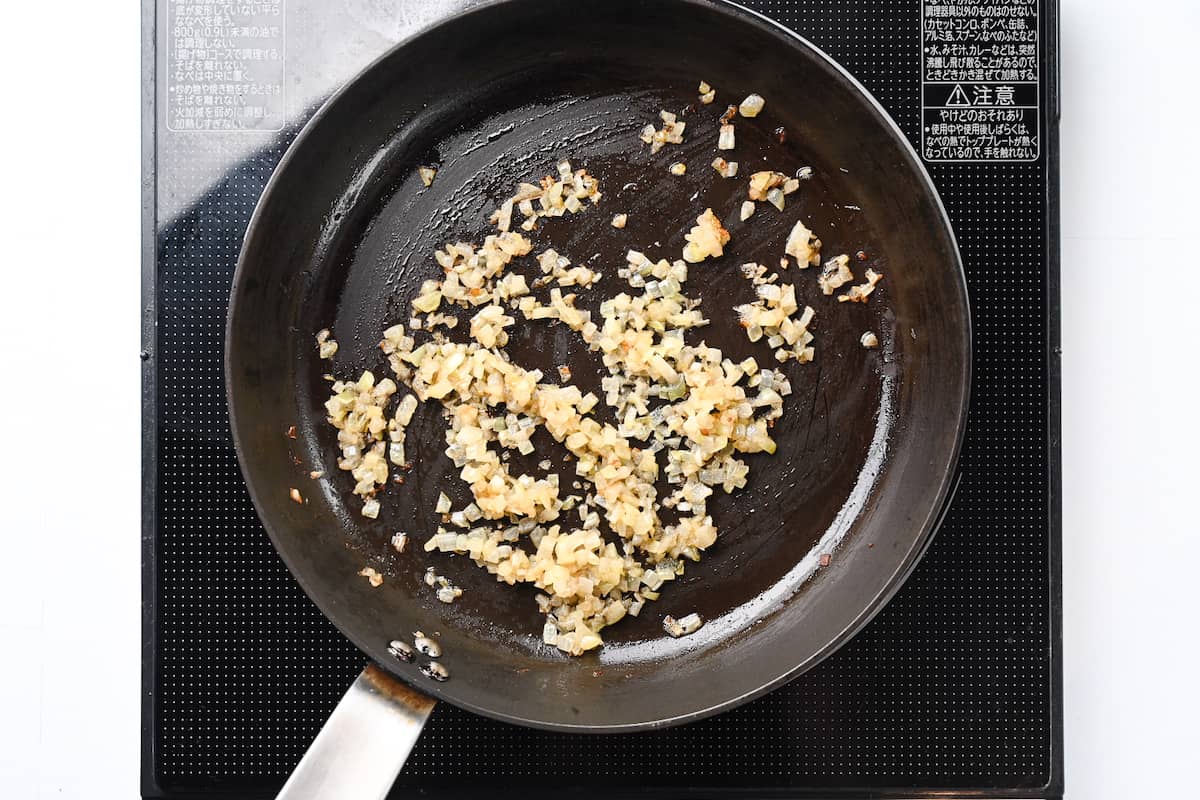
Once cooked, let it cool thoroughly before adding to the patty mixture. I recommend transferring it to a large plate to speed up the cooling process. (You could even chill the plate to speed it up further!)
Once your onions have cooled down, add them to a bowl with the ground meat and season with salt, pepper, and a pinch of nutmeg. Mix by hand until the ingredients are evenly distributed. In a smaller bowl, add the panko breadcrumbs and milk.
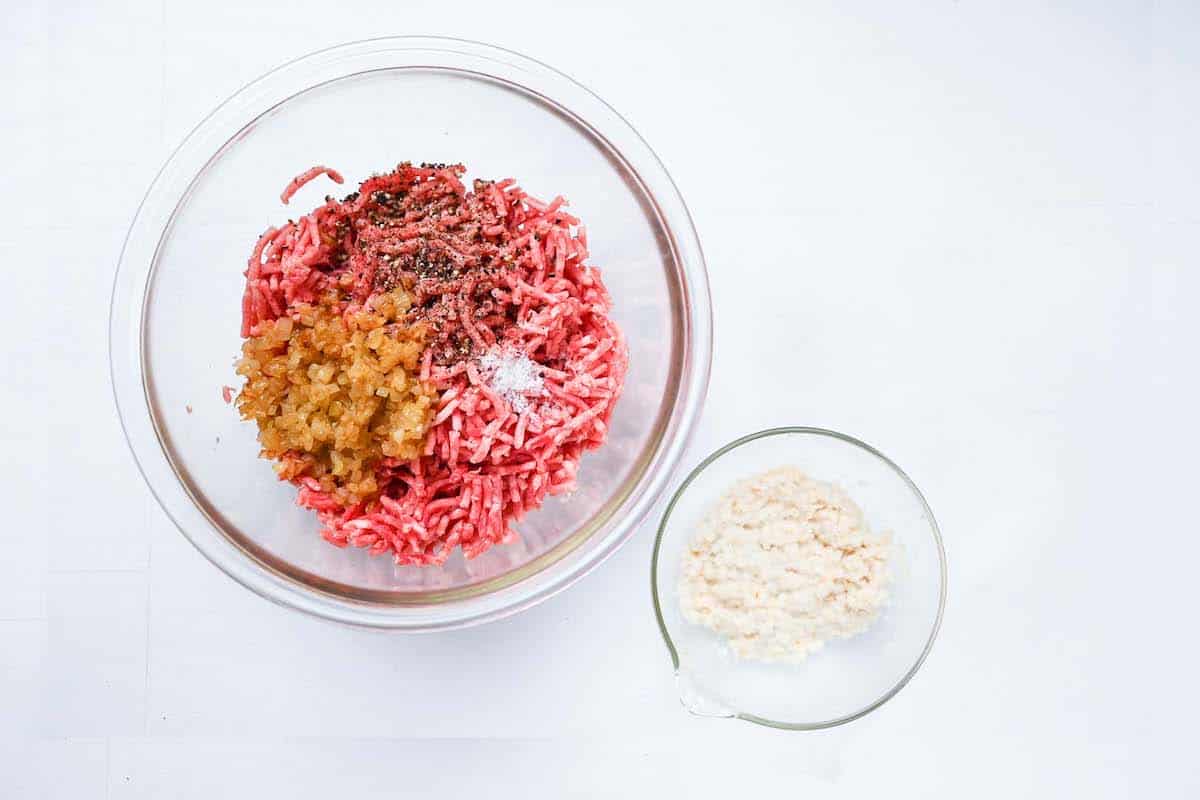
High room temperature, warm ingredients, or even the warmth from your hands can cause the fat in the meat to melt and lead to a dry patty. Keep the patty mixture as cool as possible by chilling the ingredients and avoiding over-mixing.
If you’re making this dish in summer, mixing the ingredients over a bowl of ice water is a great way to keep them cold!
Add the panko and milk mixture to the bowl and mix again.
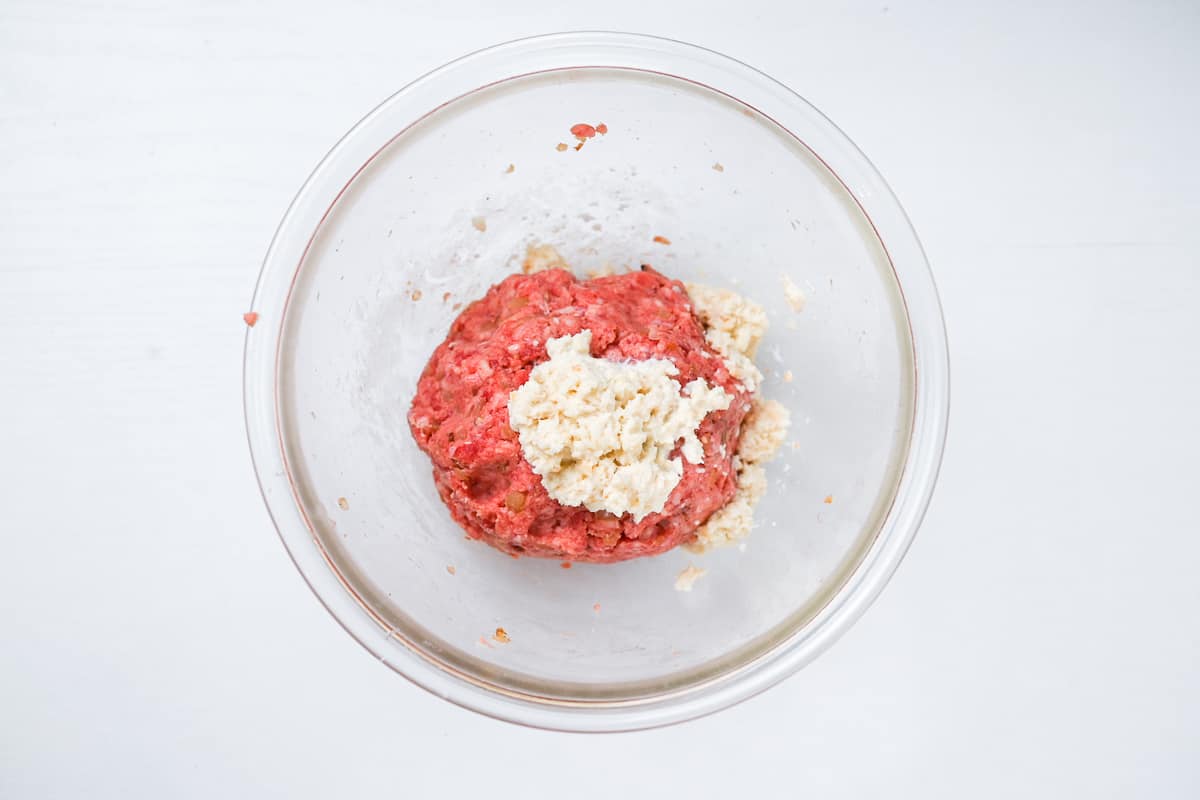
Kneading by hand will ensure the ingredients are evenly distributed throughout the mixture!
Divide the mixture and shape them into patties. Avoid handling the patties too much, otherwise, the texture will become dense and dry.
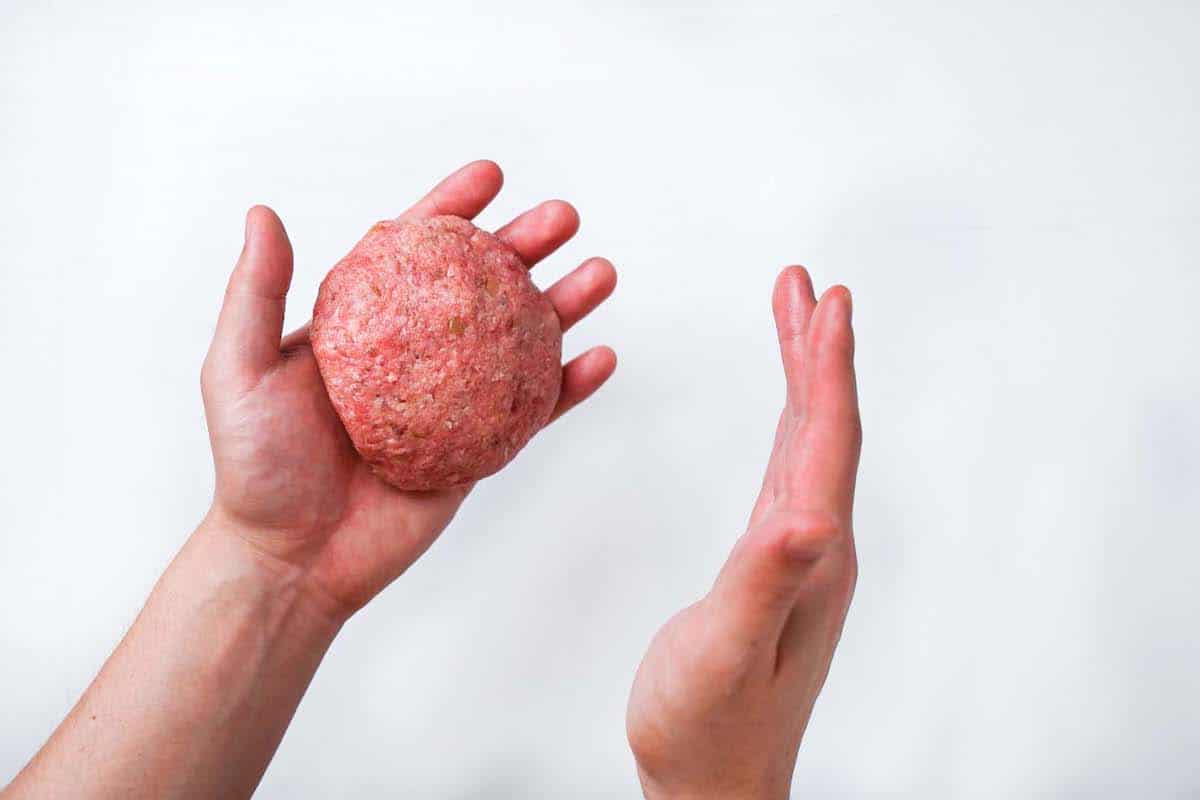
Knock the air out of each patty by throwing them from one hand to the other a few times. If air is left in the mixture, it can expand when cooking, causing cracks on the surface. Not only does this ruin the appearance, but it can also cause the juices to leak out, resulting in a dry hambagu.
Tossing the patties also helps prevent them from becoming too warm and over-handled.
When you shape the patty, ensure the surface is smooth. This will help seal the surface evenly when cooking, trapping the juices and ensuring your hambagu is moist and flavourful.
Meat tends to shrink as it cooks, and in the case of hambagu, the bottom and edges start to shrink first, which can cause the center to puff up and make a dome shape. Make a dent in one side of the patty to stop it from puffing up. It will cook more evenly too!
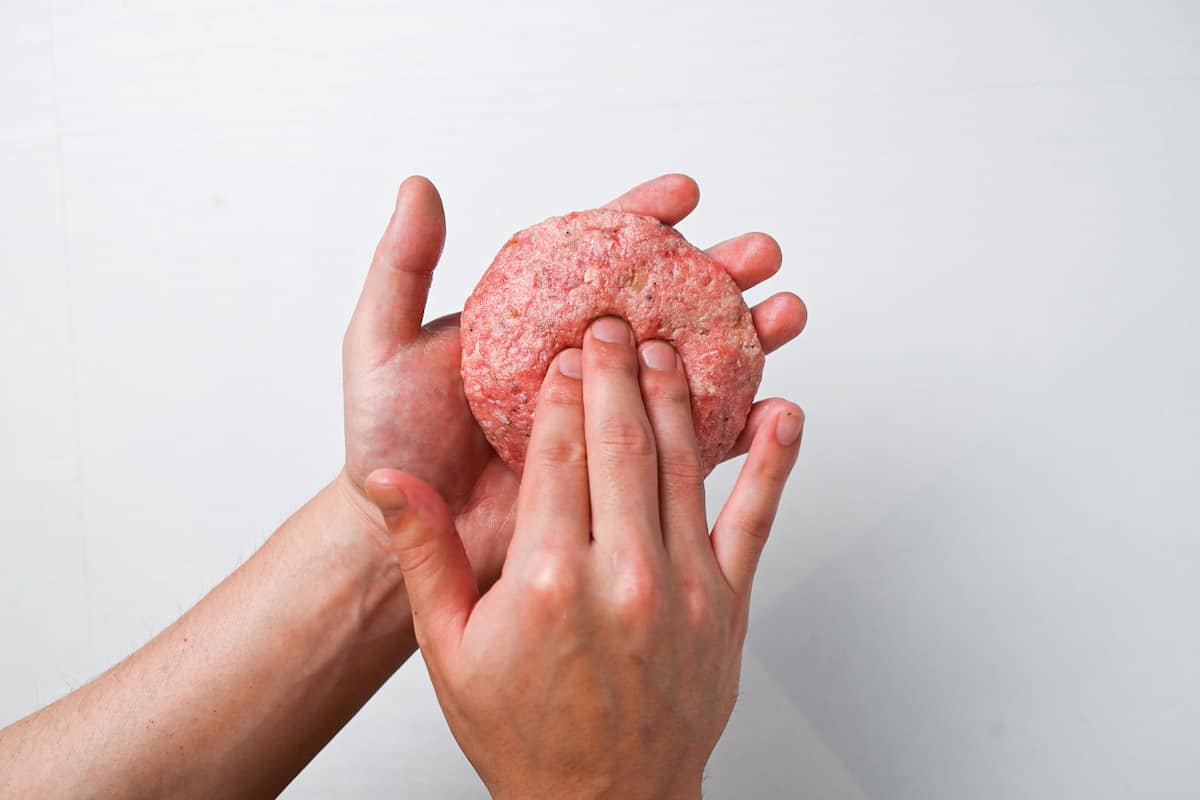
Once you’ve shaped the patties, cover them and rest them in the refrigerator for 30 minutes. Not only does this stabilize the shape, but it also allows the seasonings to absorb deeper into the meat, creating a richer flavor.
Preheat your frying pan on a medium-high setting. Once hot, add vegetable oil and place the patties in the pan with the dented side facing up. Fry for a few minutes or until browned and crispy on one side.
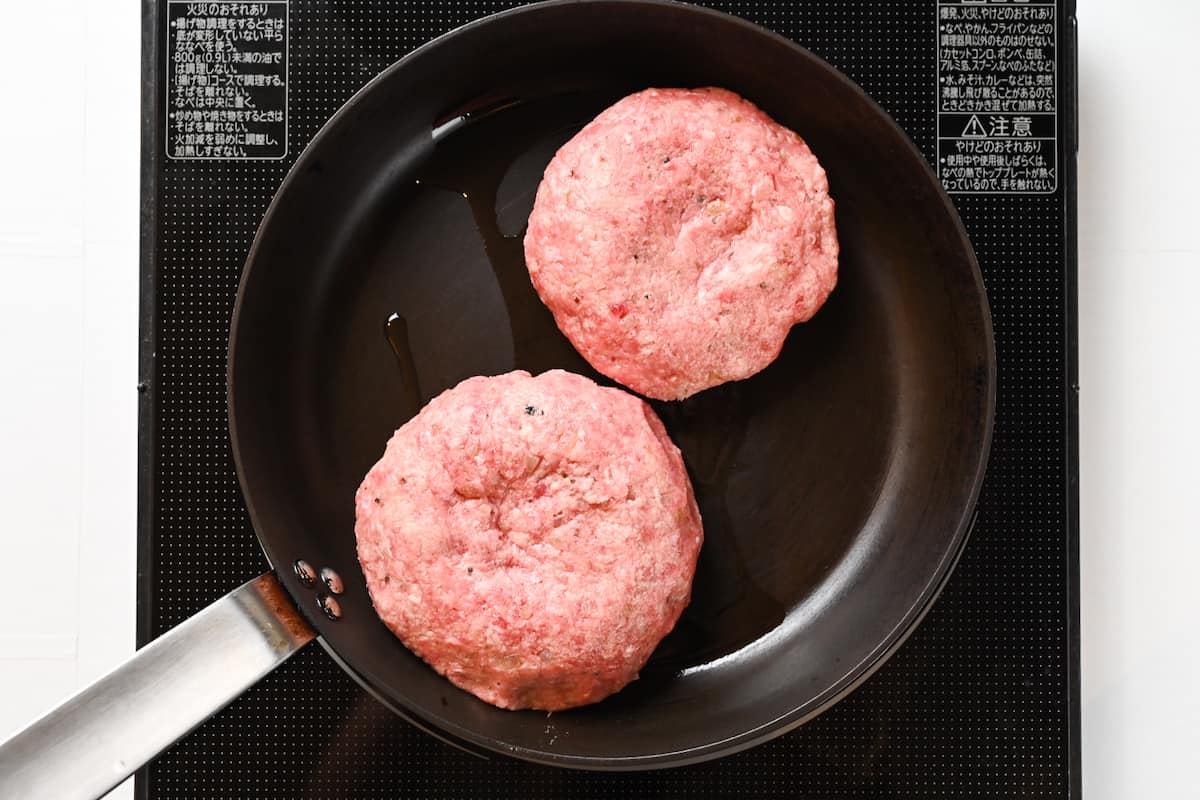
Once crispy, turn the patties over and lower the heat to medium-low. Continue to fry for 3-4 minutes.
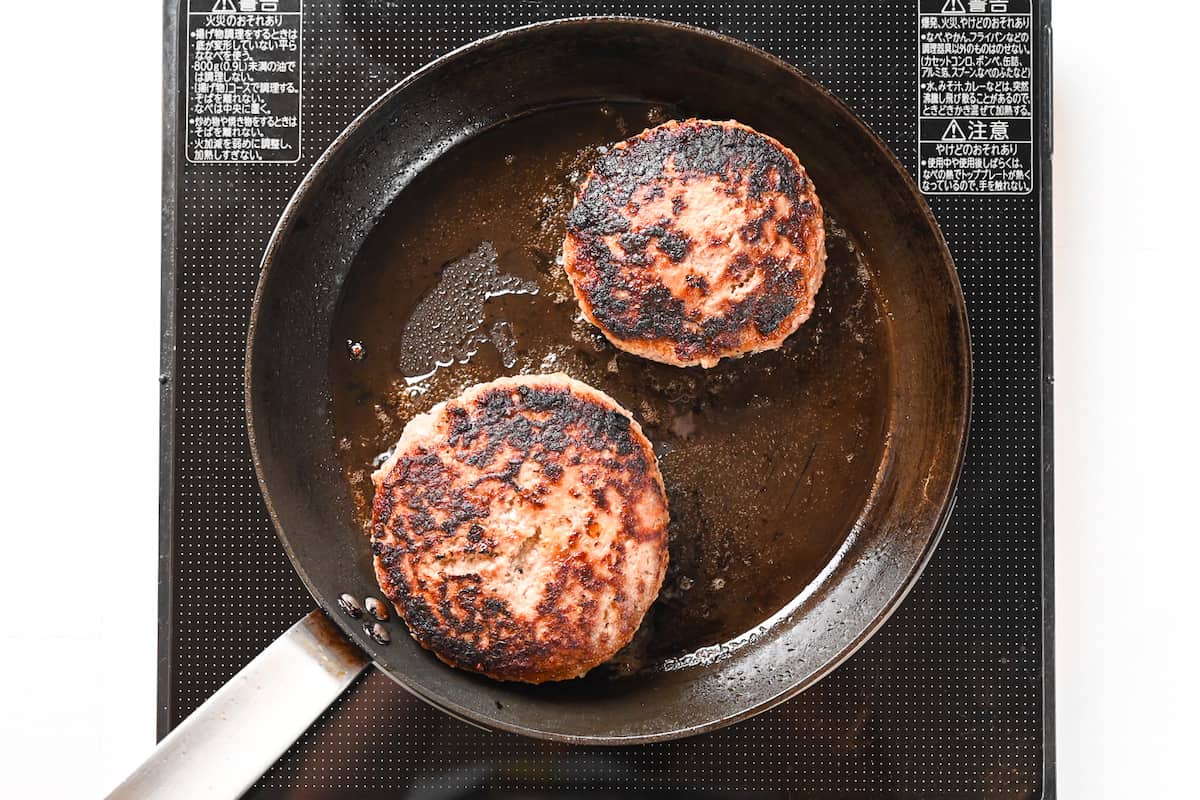
Check the doneness by piercing the thickest part of the patty. If the juices run clear, then they’re cooked. If they are red or pinkish, then they need longer. Alternatively, you can use a cooking thermometer. Hambagu should reach an internal temperature of 70°C (160°F) before serving.
Tip: If the hambagu isn’t fully cooked through and is starting to burn on the outside, lower the temperature and place a lid on top. This will help it continue to cook without drying out or burning.
Once cooked, transfer to serving plates.
To fully use the juices from the meat, use the same frying pan and add ketchup, Worcestershire sauce, mustard, and honey.

Mix well and simmer for 2-3 minutes or until slightly thickened.
Serve your homemade Japanese hambagu with your favorite sides and add a generous helping of your cheat demi-glace style sauce!
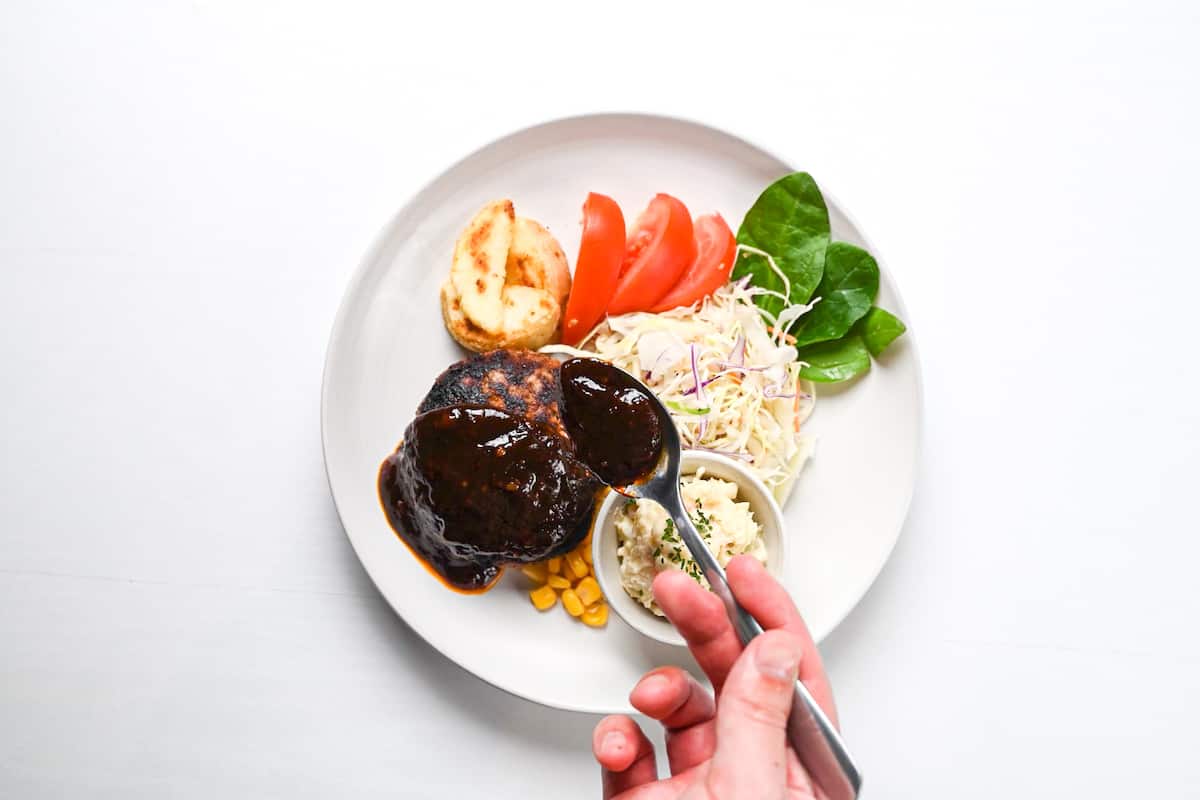
Enjoy!
Jump to Full Recipe MeasurementsHow to Store
To store cooked hambagu, freezing is the best option. First, wrap each hambagu loosely in plastic wrap, but ensure it’s sealed well.
Place in a freezer bag, remove as much air as possible and store for up to a month. To reheat, microwave the frozen burger, still wrapped, at 600W. Small to medium patties can take as little as 2 minutes, but increase the time for larger hambagu and ensure it’s piping hot before serving. The sauce should be stored separately and will last 3-4 days in the refrigerator or approximately 1 month in the freezer.
If refrigerated, consume within 2 days.
Storage summary
Room temperature – Not recommended.
Refrigerated – Hamburg, up to 2 days. Sauce only, 3-4 days.
Frozen – Up to a month.
FAQ
Hamburg steak pairs well with fried eggs, potato salad, mashed potatoes, potato wedges, coleslaw, rice, and soup as toppings or sides.
Hamburger steak, or hambagu, gained popularity in Japan for its affordability, versatility, and adaptability to Japanese tastes. The budget-friendly mix of beef and pork and its convenience contributed to its widespread appeal.
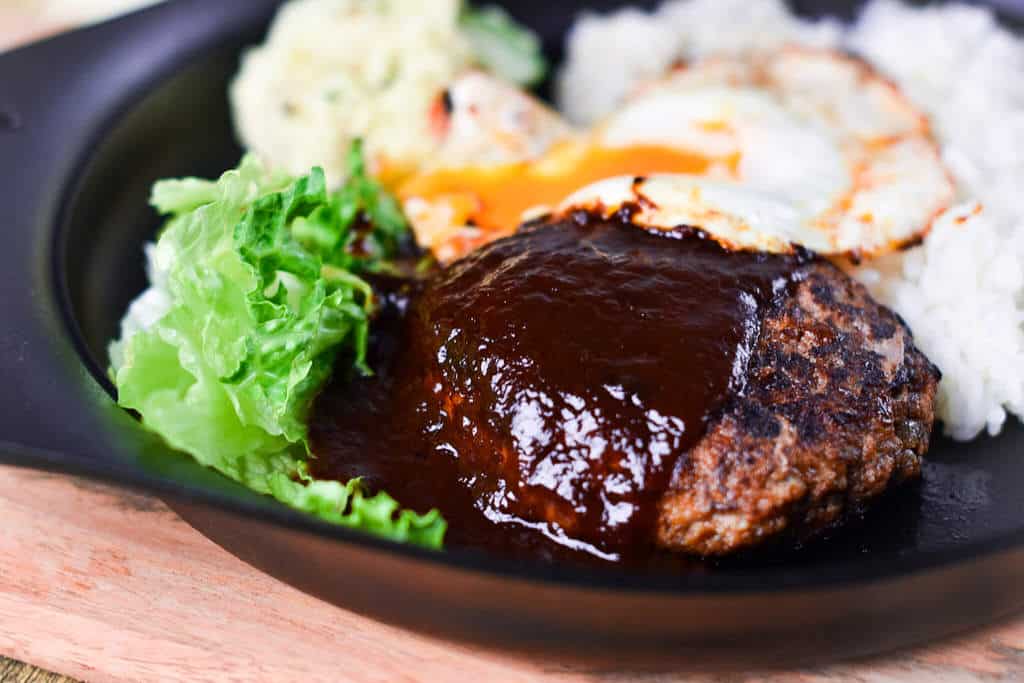
I hope you enjoy this Japanese Hambagu recipe! If you try it out, I’d really appreciate it if you could spare a moment to let me know what you thought by giving a review and star rating in the comments below. It’s also helpful to share any adjustments you made to the recipe with our other readers. Thank you!
More Japanese Dinner Recipes
- Best Tonkatsu (Deep-fried Japanese Pork Cutlet)
- Beef Hayashi Rice (Without Roux Packet)
- Japanese Style Mapo Tofu (Mabo Dofu)
- Teriyaki Beef Rice Bowl with Wasabi Twist
Want more inspiration? Explore my Japanese Dinner Recipe Roundup Post for a carefully selected collection of tasty recipe ideas to spark your next meal!
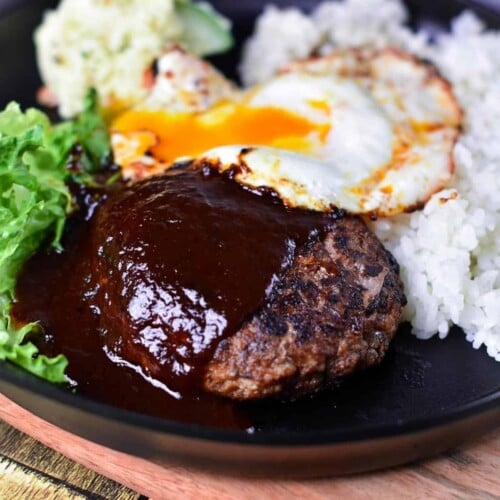
Japanese Hamburger Steak with Egg and Rice (Hambagu)
Ingredients
Hambagu patties
- 2 tsp butter
- ½ yellow onions finely diced
- 4 tbsp panko breadcrumbs
- 3 tbsp milk
- 300 g ground beef or a blend of 70% beef and 30% pork
- 1 pinch nutmeg powder
- ¼ tsp ground black pepper
- ¼ tsp salt
- 1 tbsp cooking oil
Hambagu Sauce
- 2 tbsp Worcestershire sauce
- 4 tbsp tomato ketchup
- ½ tbsp smooth Dijon mustard
- 2 tsp honey
My recommended brands of ingredients and seasonings can be found in my Japanese pantry guide.
Can’t find certain Japanese ingredients? See my substitution guide here.
Instructions
Hambagu patties
- Heat a frying pan on medium. Once hot, add 2 tsp butter and ½ yellow onions (diced). Fry until slightly soft and translucent, then remove from the heat and cool completely before moving to the next step.

- Mix 3 tbsp milk and 4 tbsp panko breadcrumbs in a small bowl. In a separate large mixing bowl, add 300 g ground beef, ¼ tsp salt, ¼ tsp ground black pepper, 1 pinch nutmeg powder and the cooled onions. Mix by hand until the ingredients are evenly distributed (but be careful not to overmix).

- Add the milk/panko mixture to the bowl and mix by hand again until evenly distributed.

- Divide the meat into portions, shape them into patties and then toss each one from one hand to the other to remove any air bubbles.

- Make a dent on one side and place them on a plate. Cover and chill in the refrigerator for 20-30 minutes.

Cooking
- Heat a frying pan on medium-high high and once hot, add 1 tbsp cooking oil. Place the patties in the frying pan with the dent side facing up. Fry for 2-3 minutes or until browned and crispy.

- Flip the patties and reduce the heat to medium-low. Continue to fry for 3-4 minutes.

- Check the patties are cooked through by piercing the thickest part with a toothpick. If the juices run clear then they're cooked. Alternatively, check with a cooking thermometer, the internal temperature should reach 70 °C (158 °F) .Tip: If the hambagu isn't cooked all the way through and is starting to burn, reduce the heat to the lowest setting and cover it with a lid. Once cooked through, rest on a plate while you make the sauce.

Sauce
- Using the same pan with the meat juices, add 2 tbsp Worcestershire sauce, 4 tbsp tomato ketchup, ½ tbsp smooth Dijon mustard and 2 tsp honey. Mix well and allow to bubble for 2-3 minutes until slightly thickened.

- Place the hamburgs on serving plates and drizzle the sauce over the top. Serve with your favorite sides and enjoy!

Video
Notes
- If you want to make the hambagu patties ahead of time, you can mix, shape and refrigerate until it’s time to cook.
- Choose between 100% beef or a blend of 70% beef and 30% pork for optimal flavor.
- Coarsely ground meat will improve the texture.
- Pairing option: miso soup.
- Optional: Lightly dust patties with flour before cooking for nice browning.
- Storage options: Refrigerate hambagu up to 2 days (sauce separately for 3-4 days) or freeze wrapped patties for up to 1 month; reheat frozen patties in microwave at 600W for approximately 2 minutes until thoroughly hot.
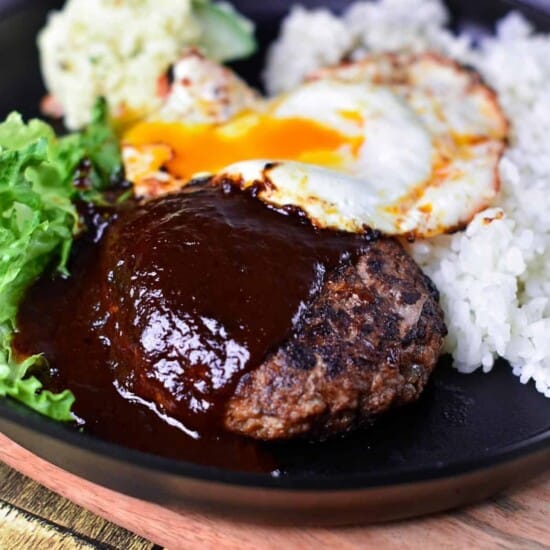



The burger itself was good. The sauce I found to be unpalatable. When I first taste tested it all I could taste was a very strong flavor of Dijon Mustard. I thought that a 1/2 Tbsp was quite a bit, but I like to try recipes as written, first. I dumped 1/2 the sauce and added another Tbsp of Ketchup and another Tbsp of Worcestershire, a Tbsp of chili paste and another 2 tsps of honey. It was still lacking something so I added a Tbsp of Fish Sauce. It still pretty good after that.
Hi Cindy,
Thank you for your honest opinion and experience! I appreciate it!
Yuto
I have lived in Okinawa for 8 years. Needless to say my family and I eat 50/50 Japanese American. Thank you so much for this… really made me miss the island. Was very good. I will say that some recipes make the sauce/gravy different and there are many variations. We had a favorite restaurant that served all different flavors. Thank you!!!
Hi Samantha,
Thank you for the comment! I’ve only been to Okinawa once, but surely one of the most beautiful places I have ever visited! Your comment made me wanna go back there again soon! 🙂
Yuto
I’ve never had hamburg steak before but this was so delicious! It was easy enough for a beginner like me to make. Thanks for this recipe!
Hi Justina,
Thank you so much for trying this recipe and sharing your photo! It looks fantastic! I’m happy to hear that the instructions were easy to follow and that you enjoyed your first hamburg steak experience!
Yuto